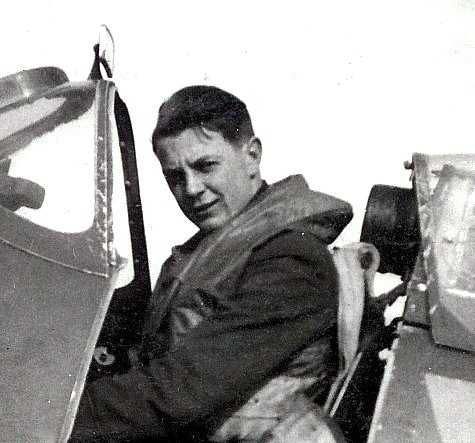|
Squadron Leader Dave Glaser, who died aged 80,
in July 2001 ,
was an RAF pilot mistakenly shot down off Plymouth, Devon, by a
British warship during the Battle of Britain. Struggling to free
himself from his parachute, which had enveloped his head, Glaser had
all but give, up hope when the chute floated away ,and he was
rescued.
Aged 19, Glaser had joined No 65 Squadron at Hornchurch on July 13 1940, just three days
after the day regarded as the beginning a the Battle of Britain, which
raged overhead until October 31, when the R.A.F's supremacy ended the
threat of German invasion.
Ernest Derek Glaser always known as Dave, was
born on April 20 1921. In the First World War his father had been a
pilot in the Royal Flying Corps. After attending Lancing House and
Bloxham schools young Dave was accepted, in April 1939 for flying
training in the Royal Air Force Volunteer Reserve.
Glaser had been inspired to become a pilot same
years earlier after meeting Jeffrey Quill
who, in 1976, as a Supermarine test pilot, had flown R.J. Mitchell's Spitfire
prototype and earliest production aircraft Quill had been a frequent
visitor to The Bugle, Glaser's father's pub on the Hamble in
Hampshire.
In 1940, Quill was temporarily attached to No 65 Squadron for as he put it, "a spot of practical"
in order to recommend
modifications in the light of combat experience. Glaser was delighted,
on his arrival, to find himself flying No 2 to his boyhood hero.
Glaser soon had examples of combat himself,
on the 12th of August he was preparing to take off from Manston, the Kent coastal
airfield, when a formation of low-flying Dornier 17s attacked the
airfield at low level, damaging hangars and cratering the flight path.
Glaser recalled: "Every body just opened up their
throttles and went bell for leather."
Awaiting the scramble bell during the Battle of
Britain Glaser had occupied him by fashioning a lucky talisman
representing The Laughing Cavalier
Glaser reckoned that together with a cavalier
which he had had painted on his Spitfire (in an example of what was
known as nose art), it helped to see him through the war.
In this period he was promoted to flight
lieutenant and was serving as a No 234 Squadron flight commander when
he wan shot down into the Channel off Plymouth.
Vowing to he more circumspect in the vicinity of
the Royal Navy, Glaser resumed operations with Group Captain
(subsequently Air Chief Marshal Sir Harry Broadhurst's Spitfire wing
based at Hornchurch, Essex, but frequently operated from Manston and
other South East England No 11 Group airfields.
Following the Battle of Britain, in 1941 Glaser
became an instructor at No 53 Operational Training Unit until August,
when he joined No 234, a Spitfire squadron carrying out offensive
sweeps over northern France.
In 1943, Glaser was posted to Australia to form
and command No 549, a Spitfire squadron stationed at Darwin in the
Northern Territory.
In the New Year of 1945 he received command of
No 548 a Spitfire Squadron similarly charged wide defending Darwin
against Japanese air attack. After two years he returned home, was
granted a permanent commission and posted to Linton-on-Ouse,
Yorkshire. There he was flight commander of No 64, a half strength
Hornet fighter squadron.
Glaser was delighted in 1949 when he was selected
to qualify as a test pilot, again following his hero Jeffrey Quill.
Glaser attended No 8 course, at the Empire Test Pilots' School, then
Situated at Farnborough Hants (and now based at Boscome Down
Wiltshire)
In 1950, Glaser was employed as an RAF
experimental test pilot at the Royal Aircraft Establishment,
Farnborough He remained there until 1953, when he joined Vickers
Armstrong at Hurn, Bournmouth Hants.
Becoming chief production test pilot, Glaser was
involved with the Varsity. This was a post war replacement for the
trainer version the of the two engine Wellington bomber. He also
tested the world's first turbine powered four engine airliner, Sir
George Edwards's Viscount - a plane then described as "a jump into the
future".
But his chief contribution was his exhaustive
production testing of the Valiant, the first of the RAF's four jet
bombers, which preceded the Vulcan and Victor in Britain's V-bomber
nuclear force.
Glaser was also involved with the BAC 1-11s, one
of Britain's best selling airliners, When, in 1963,he first flew the
jet, he handled it like a Spitfire and was apt to fly over Hum
airfield so low that onlookers were put in mind of a Flymo.
In 1979 Glaser was appointed (flight operations
manager and test pilot instructor of Rombac, an arrangement under
which BAC 1-11s were built under licence in Romania, where his robust
airmanship was much admired by his pupils,
Glaser retired in 1983 from British Aerospace -
as Vickers B.A.C. and other merged aircraft manufacturers had become
and worked as an aviation consultant, while deriving much pleasure from
sailing.
He was also invited to join-a road-show of
British American and German Second World War pilots, which toured
American theatres under the billing A Gathering of Eagles.
Glaser received the D.F.C. in 1942 and Air
Efficiency award in 1946. He was awarded Queen's Commendations for
Valuable Service to the Air in 1953 for military, and in 1968 for test
flying.
Glaser married first in 1949, Cora Gillie, an
Australian. They had a son and a daughter, He married, second, in 1965
Diana Stewart-Smith, and, third, in 1985, Rodica Ghita a Romanian.
All this info was taken from
the Daily Telegraph 16th of July 2001
|

